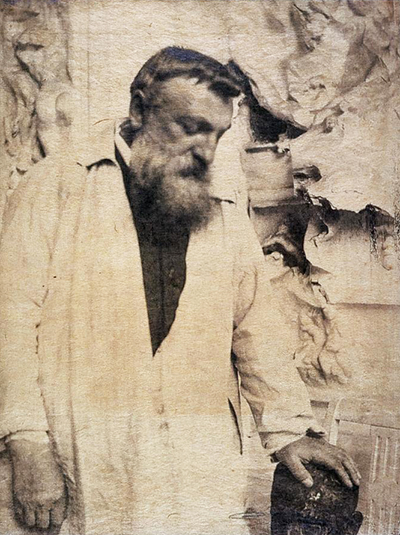Rodin would often see his sculptured creations as real people, and this photograph gives an insight into that. He pats the head of one of his sculptures with a kindness and comforting way that we might give to a family pet or young child.
The artist was a large character, both in size and charisma, but he had a gentle touch when working. He found a sexual connection with some of the female portraits from his career, and would spend so much time amending each sculpture that he would build up a relationship with them over time. He also used live models many times and perhaps this contributed to the blurring of reality within his perception. The photograph itself was taken by Gertrude Kasebier who was an American photographer who travelled to Paris for a variety of reasons in the 19th century. Rodin loved to welcome the best exponents of this art form to his studio in order to capture him at work, as well as to document the progress of different projects that he was working on. They in return would sometimes receive payment in the form of some of his sculptures or drawings when he was particularly keen on what they produced during their visit.
He appears to be deep in thought at the time of this photograph, perhaps contemplating a current project. He is standing alongside a sculpture, wearing the overcoat which was to protect his normal, everyday clothing whilst walking around his studio. There would have been all manner of materials lying around within his creative workspace that could potentially ruin the smart suit that he appears to be wearing underneath this unflattering, thick artist's clothing. His age can be judged by his beard, which slowly greys, then whitens over the years, with each stage captured within the many thousands of photographs that were taken within his studio. His hair cut was normally short and simple, with his beard relatively unstyled. He had a prominent nose and thick build that added to his look of a strong, powerful individual that was not to be argued with.
Sculpture studios are always interesting places for photographers to capture, with three dimensional items found all over each room, in most cases. Photographers can focus on different angles as well as considering the role of light upon different materials. They could potentially also re-arrange some of the smaller artworks for various effects, although it is hard to imagine Rodin allowing anyone to come in and do such a thing. He saw himself as the director, instructing them to perform a service for him, entirely under his guidance. That said, there was still no shortage of people willing to come in and help out, no doubt excited to see into his extraordinary world and also to make use of his beautiful sculptures.




